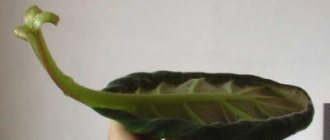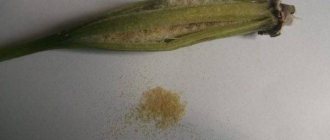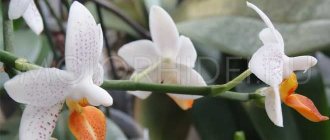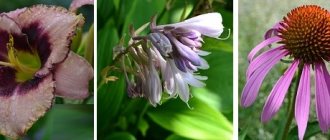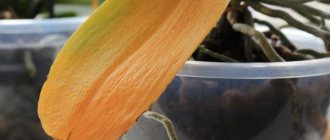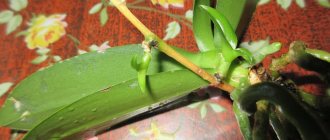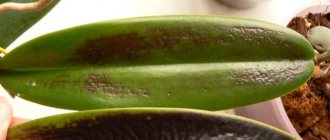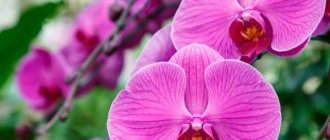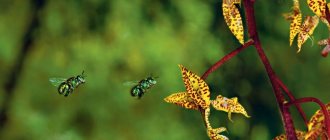Replenishing the collection or the need to replant an overgrown plant forces novice gardeners to study propagation methods. They often wonder whether it is possible to propagate an orchid from a leaf. Experts give a clear answer: this is impossible. The only possible option is a leaf with a section of the trunk and a dormant bud. If it grows, you can get a baby and transplant it. But for this it is important to create suitable conditions for reproduction.
Structural features of orchids
Representatives of the Orchid family have special features that are characteristic only of these tropical plants. They are divided into two large groups according to growth types:
- monopodial;
- sympodial.
Orchids belonging to the first, monopodial type grow leaves at the top of the stem, developing upward. Each new leaf plate is larger in size than the previous one. Plants have a single growth point - the apical one.
The sympodial type is distinguished by the fact that the growth vector of flowers is directed not only upward, but also to the side. In such plants, the rhizome, which is scientifically called a rhizome, constantly produces young shoots. When they mature, they cease their development forever. Orchids can have several growth points. They arise from new shoots that turn into pseudobulbs over time.
It is not possible to propagate orchids from leaves; larger parts of the plant are suitable for this: lateral shoots and layering, pseudobulbs, seeds or apical cuttings. All of them have a growth point, which is absent from the leaf blade.
Aftercare
Successful rooting is only the first step in orchid propagation.
A young plant needs to create optimal conditions for growth and development. An exotic flower needs lighting at least 12 hours a day. It is recommended to place it on an east or southeast window. Comfortable temperature depends on the type of orchid, but the average for summer is 18-25°, and for winter – 12-15°. The orchid does not need frequent and abundant watering; it tolerates a lack of moisture more easily than its excess. The water should be warm, soft, preferably boiled. Moisten the substrate when it dries.
The watering regime varies significantly depending on the time of year. In spring and summer, during the period of activity and flowering, the orchid is moistened 1-2 times a week, in winter - 2 times a month. Experts determine the need for watering by the color of the roots; when they become light, it’s time to moisten the plant.
Feeding of a young plant begins 2 weeks after planting. Use a special complex fertilizer with minerals and trace elements. A special feature of the application is to reduce the recommended dosage by 3-5 times.
Fertilizing with a high nitrogen content helps accelerate growth. It is performed 2 times a month. When the orchid grows, it is transplanted into a larger pot.
Advice
As a precaution, the pot with the orchid seedling can be kept in greenhouse conditions for another 2 weeks.
High air humidity is a significant factor for the comfortable state of an orchid. Depending on the variety, the recommended humidity is 60-70%. The plant responds well to spraying. It is contraindicated only for orchid flowers.
An orchid propagated by cuttings blooms in the second or third year of life. This delicate and capricious plant requires competent and systematic care. If the requirements for reproduction and maintenance are met, it will respond with beautiful flowering.
Propagation of orchids by leaf
Orchid leaves do not have cuttings. They cannot take root. Therefore, the answer to the question whether it is possible to grow an orchid from a leaf is clearly negative.
Why is this not feasible?
An indispensable condition for reproduction is the presence of a growth point. Unlike most indoor flowers, representatives of the Orchid family do not have a growing point on the stem from which leaf blades are formed. For example, violets can be grown from leaves for two reasons:
- the growth point is on the rosette;
- the leaves have cuttings that are dipped in water or a stimulating solution to produce roots.
Important! The orchid has leaves without stems. They consist exclusively of leaf plates that are not capable of producing roots.
With part of the trunk
Despite the absence of growth points on the leaves, it is possible to restore plants from one leaf blade. But this requires that in addition to it, the section of the trunk to which it is attached must be preserved.
Experienced gardeners call such areas “heels.” They can be rooted and new orchids can be obtained. The likelihood that part of the trunk with the leaf will take root is high. But for this, the flower must be provided with suitable growing conditions.
In nature, the plant is most often found in the tropics, where certain air humidity and temperature are maintained. When keeping at home, it is necessary to recreate natural conditions as closely as possible:
- Humidity. This figure should not fall below 50%. However, humidity above 80% has a detrimental effect on orchids and should be avoided.
- Temperature. Heat-loving inhabitants of tropical thickets feel comfortable at an air temperature of at least +280C.
The likelihood of successful heel rooting can be affected by the condition of the plant and the season. The most successful results are observed in spring or at the end of the flowering phase.
Important! Only healthy specimens are suitable for reproduction. An exception may be diseased plants that cannot be saved. In such situations, you can try to propagate the orchid by leaf.
Cuttings
How to properly propagate an orchid by cuttings?
stem
For sympoidal orchid species, the method of obtaining cuttings from pseudobulbs is suitable.
Basic rules for cutting
Cut so that there are one or two kidneys on each piece.
Orchid sections must be treated with brilliant green or iodine.
All cut areas should be powdered with crushed coal. Iodine and brilliant green are not used.
Attention! Wounds on the mother plant are treated in the same way as cutting cuttings.
Planting in the substrate
The substrate must be prepared in advance. Place the cuttings in damp moss, spray with a biostimulant and be patient. In about a month, the most promising buds will wake up and delight the owner with green sprouts.
Using a mini-greenhouse for rooting
You can’t just plant cuttings and forget about the greenhouse for a month. Ventilation for a few minutes is necessary every day. It is necessary to provide light and warmth, and temperature differences between day and night within 4-7 degrees have a beneficial effect on growth.
Peduncle
Material selection
How is an orchid propagated using a peduncle? Choose a strong, healthy plant with well-developed peduncles. The branch should be:
- Tolstoy;
- Rich green color.
They begin immediately after the end of flowering, when the flowers have begun to fade, but the apical bud is still fresh. The peduncle is cut so that each cutting has one or two buds. Be sure to powder the sections with crushed charcoal, or activated charcoal. When the baby grows up, carefully cut it off the peduncle.
Important! The lower the bud was on the mother plant, the greater the likelihood of getting a strong sprout from it.
Germination medium
In order for the bud to “wake up” and develop a viable shoot, optimal conditions must be maintained for a long time:
- Bright diffused light;
- Warm humid air around 25C;
- Greenhouse conditions with high humidity.
To do this, it is good to organize a greenhouse with damp sphagnum moss, which needs to be ventilated every day. This will help avoid rotting.
Planting in a nutrient medium
The cuttings are placed in a greenhouse in a “lying” position, that is, horizontally. The greenhouse needs to be prepared in advance.
The cuttings are laid evenly so that there is a distance between them.
The prepared cuttings are laid in even rows so that there is a distance between them and as much surface as possible is illuminated.
Using Knudson's nutrient medium to awaken the growth point
When breeding orchids, Lewis Knudson's nutrient medium is used. Among inexperienced gardeners, there is a widespread belief that it can be used to root plants and awaken their growth points.
The purpose of any nutrient solution is to grow certain microorganisms. Knudson's medium is intended only for germinating seeds of representatives of the Orchid family. In rare cases, it is used for cell cloning.
This substrate is prepared on the basis of agar-agar, which is obtained from red and brown seaweed. Dissolving in water, it acquires a jelly-like consistency.
Advice! In order to awaken the growth point, you can use cytokinin paste. It is applied to the dormant bud with a clean needle or toothpick.
Possible errors during reproduction
Growing orchids is very difficult. Some violations during the reproduction procedure can lead to unsatisfactory results.
Reproduction errors
The most common mistakes of inexperienced gardeners:
Infection. If you do not follow the rules for cutting cuttings, during the procedure you can introduce an infection that will lead to rotting of the mother plant. To prevent this from happening, before cutting off the necessary parts of the flower, it is necessary to disinfect all cutting tools, and treat the branches with activated carbon powder. Incorrect separation of children. You need to separate the babies from the mother flower very carefully. Otherwise, the risk of plant damage and then death increases. Before planting, you need to separate the children from the peduncles, otherwise, when the remaining part of the peduncle rots, they too will begin to rot. Mistakes in caring for young flowers
It is especially important to comply with the norms of humidity, frequency of watering, temperature and lighting. Baby orchids are less resistant to the external environment than adult plants
Improper care can destroy them.
Orchid propagation is a process that affects the development of a tropical flower, on which the future life and health of the plant depends. Proper care of young offspring will allow them to go through the recovery period faster.
Reproduction of orchids by children from leaf axils
This method of reproduction is one of the most common and simplest. Most often, dendrobiums and phalaenopsis are bred with its help. In plants that have reached two years of age, growth points appear in the axils of the leaves and on the peduncles. Children can develop from these buds. They are formed independently or as a result of stimulation. This procedure is carried out in February and consists of:
- reducing watering;
- cancellation of fertilizing;
- reducing night temperatures to +170C;
- maintaining the temperature during the day at about 270 C;
- protection from direct sunlight.
From the awakened buds, children develop with their own roots. This process takes from 5 to 8 months. After the baby grows 3-4 leaf blades and its own root system at least 5 cm long, it is separated from the mother plant and transplanted into a new pot:
- dry for 2-3 hours;
- treat the sections with activated carbon;
- pour substrate for orchids into the planting container;
- drop off the baby;
- place the pot in a mini-greenhouse.
Planting orchids in different containers
When you have prepared the soil, you need to decide on the container for planting and the planting material itself. The cuttings must be fresh, without visible diseases, and not withered. Here are the rules for planting cuttings, taking into account the selected container:
- Orchid pots are most popular among experienced gardeners. Fill 1/3 of the container with drainage. These can be pieces of bricks, shards, foam crumbs. Install a wire mesh and a peg, which will later serve as a support for the flower. Place the cutting on top. Fill with soil so that the stem remains on top of the soil.
How do orchids reproduce?
In nature, orchids reproduce primarily sexually. One flower can produce up to four million seeds! The seeds are very small and have no supply of nutrients. Therefore, for the germination of a new orchid, a specialized substrate is required. As a rule, these are a certain type of mushroom.
At home, propagating an orchid using seeds is labor-intensive and requires special conditions and skills. This method of breeding is used mainly in greenhouse conditions for breeding on an industrial scale, as well as for obtaining new varieties and hybrids.
The vegetative method of propagation, using various parts of the plant, is the simplest and most accessible. And even a beginner can get a new specimen genetically similar to the mother’s. Orchids reproduce by offspring, layering, cuttings, and division from the roots.
propagation of orchids by layering
orchid propagation by division
orchid propagation by cuttings
propagation of orchids by daughter bulbs
